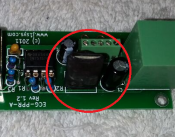Navigation
Install the app
How to install the app on iOS
Follow along with the video below to see how to install our site as a web app on your home screen.
Note: This feature may not be available in some browsers.
More options
You are using an out of date browser. It may not display this or other websites correctly.
You should upgrade or use an alternative browser.
You should upgrade or use an alternative browser.
Source for regulator/buck used in J1Sys Boards
- Thread starter Wolfie
- Start date
You can get them from Digikey or Mouser (both in the USA). Part number is OKI-78SR-5/1.5-W36-C
Just remember that the eBay DC-DC converters often use counterfeit parts and often fail to meet the claimed specs.
That said, I sometimes use them for non-critical applications and never near their rated max specs.
That said, I sometimes use them for non-critical applications and never near their rated max specs.
Wolfie
Full time elf
- Thread starter
- #5
Thank you for the part #s! I will hit mauser tomorrow.
I want them to power Max485 chips so I don't have to send 12v and 5v as well as the twisted data pair down the wire to the pixels. Almost no current so the tiny ones will suffice. I won't be driving pixels with them if thats what yall were thinking.
I want them to power Max485 chips so I don't have to send 12v and 5v as well as the twisted data pair down the wire to the pixels. Almost no current so the tiny ones will suffice. I won't be driving pixels with them if thats what yall were thinking.
You could use a standard 7805T regulator with a couple of capacitors instead of the OKI if you're only powering the MAX chip.
multicast
Senior elf
- Joined
- Jul 13, 2013
- Messages
- 715
Wolfie said:Aren't they fairly inefficient compared to these buck types? I don't want to waste pixel power on inefficient regulators that turn 12v into heat.
you said it was tiny current. So the amount of power you are talking about wasting is going to be small.
Wolfie
Full time elf
- Thread starter
- #9
Yes. But I thought they wasted quite a bit of power doing what they do, even for low current applications. Typical use also requires (or at least recommends) use of filter caps which makes its footprint actually physically larger than the tiny buck converter.
So the buck consumes less power, makes less heat, and is smaller.
These are going to be used away from a PSU at the end of a cable run. I don't want to loose any more pixel power than I have to which is why I was looking for the buck.
So the buck consumes less power, makes less heat, and is smaller.
These are going to be used away from a PSU at the end of a cable run. I don't want to loose any more pixel power than I have to which is why I was looking for the buck.
multicast
Senior elf
- Joined
- Jul 13, 2013
- Messages
- 715
Wolfie said:Yes. But I thought they wasted quite a bit of power doing what they do, even for low current applications.
They are a linear device. The amount of energy lost is directly proportional to the current and the voltage differnece between input and output.
If you put in 12V into a 7805 then the Voltage drop across it is 7V. Multipy that by the the current that your device will draw and thats the amount of power it will dissiipate.
Examples;
(12-5) * 10mA = .07W ( quite accetable )
[SIZE=78%](12-5) * 1A = 7W ( its going to get very hot without cooling it and waste lots of power[/SIZE]
A buck regulator may be more efficent at its rated power, ( say 1A output ) but the tiny powers yuo are talking about, it likely to be less effienct. A buck requires some power for itself to run as well, which may be greater than the loss's that a linear regular would present.
Its all about your applicaiton. A buck does not always present the best option
Buck regulators also need caps. Some of the "on board" types will have the caps built in, but some requrie you ti provide inout and output caps as well.Typical use also requires (or at least recommends) use of filter caps which makes its footprint actually physically larger than the tiny buck converter.
In some circumstances, but not in all.So the buck consumes less power, makes less heat, and is smaller.


